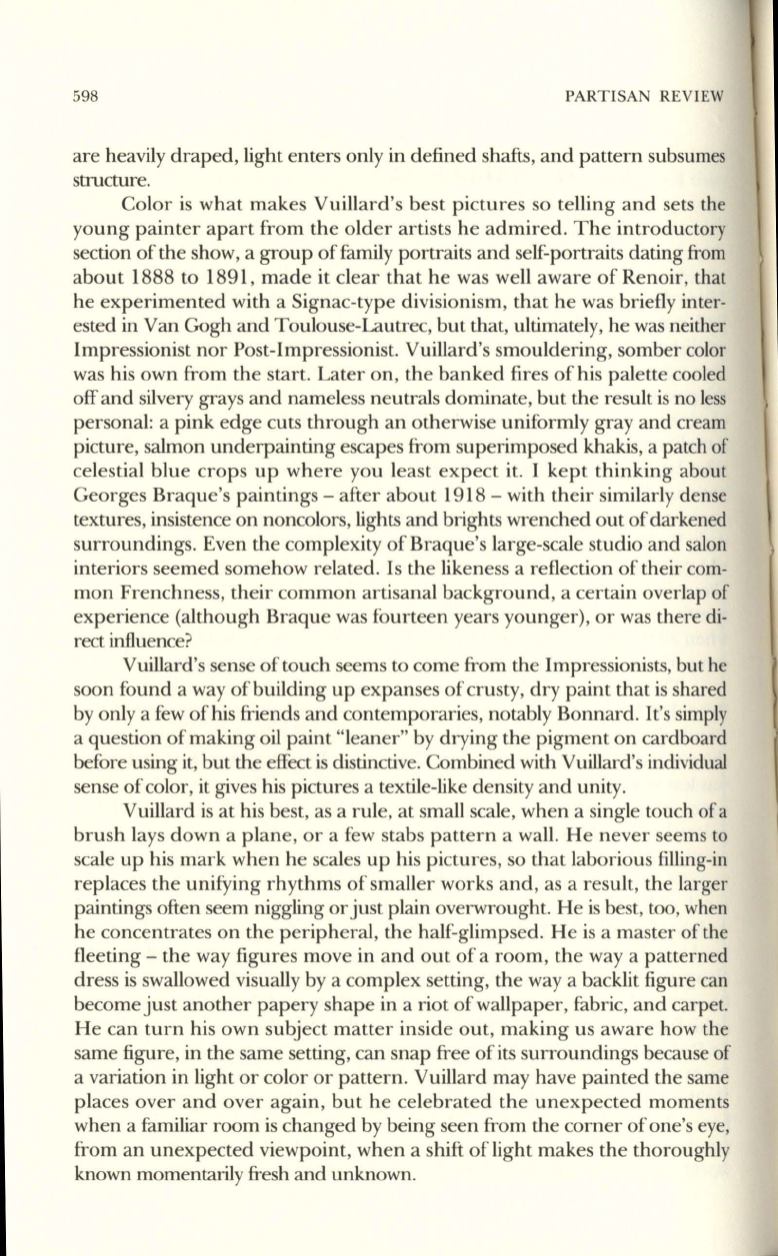
598
PARTISAN REVIEW
are heavily draped, light enters only in defined shafts, and pattern subsumes
structure.
Color is what makes Vuillard's best pictures so telling and sets the
young painter apart from the older artists he admired. The introductory
section of the show, a group offumily portraits and self-portraits dating from
about 1888 to 1891, made it clear that he was well aware of Renoir, that
he experimented with a Signac-type divisionism, that he was briefly inter–
ested in Van Gogh and Toulouse-Lautrec, but that, ultimately, he was neither
Impressionist nor Post-Impressionist. Vuillard's smouldering, somber color
was his own from the start. Later on, the banked fires of his palette cooled
off and silvery grays and nameless neutrals dominate, but the result is no less
personal: a pink edge cuts through an otherwise uniformly gray and cream
picture, salmon underpainting escapes from superimposed khakis, a patch of
celestial blue crops up where you least expect it. I kept thinking about
Georges Braque's paintings - after about 1918 - with their similarly dense
textures, insistence on noncolors, lights and brights wrenched out ofdarkened
surroundings. Even the complexity of Braque's large-scale studio and salon
interiors seemed somehow related. Is the likeness a reflection of their com–
mon Frenchness, their common artisanal background, a certain overlap of
experience (although Braque was fourteen years younger), or was there di–
rect influence?
Vuillard's sense of touch seems to come from the Impressionists, but he
soon found a way of building up expanses of crusty, dry paint that is shared
by only a few of his friends and contemporaries, notably Bonnard. It's simply
a question of making oil paint "leaner" by drying the pigment on cardboard
before using it, but the effect is distinctive. Combined with Vuillard's individual
sense of color, it gives his pictures a textile-like density and unity.
Vuillard is at his best, as a rule, at small scale, when a single touch of a
brush lays down a plane, or a few stabs pattern a wall. He never seems to
scale up his mark when he scales up his pictures, so that laborious filling-in
replaces the unifying rhythms of smaller works and, as a result, the larger
paintings often seem niggling or just plain overwrought. He is best, too, when
he concentrates on the peripheral, the half-glimpsed. He is a master of the
fleeting - the way figures move in and out of a room, the way a patterned
dress is swallowed visually by a complex setting, the way a backlit figure can
become just another papery shape in a riot of wallpaper, fabric, and carpet.
He can turn his own subject matter inside out, making us aware how the
same figure, in the same setting, can snap free of its surroundings because of
a variation in light or color or pattern. Vuillard may have painted the same
places over and over again, but he celebrated the unexpected moments
when a familiar room is changed by being seen from the corner of one's eye,
from an unexpected viewpoint, when a shift oflight makes the thoroughly
known momentarily fresh and unknown.


